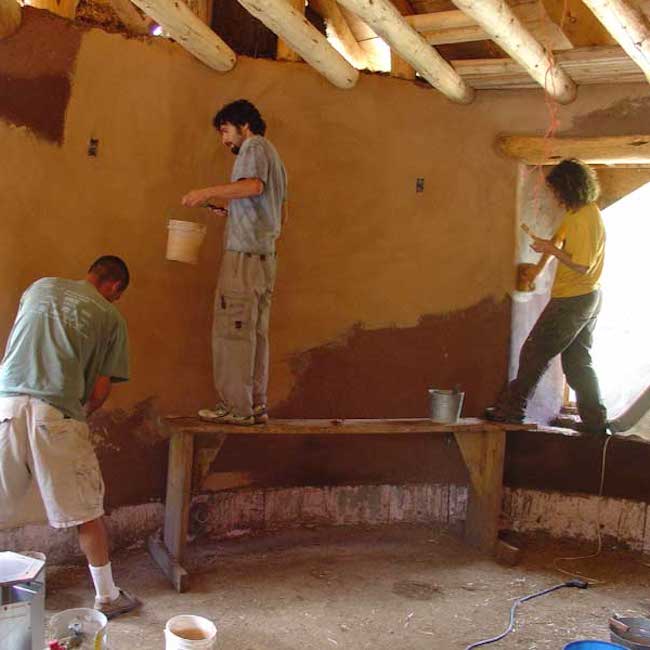Whether you want to give your home a more earthy character, or you’re afraid of harmful chemicals in conventional paints, or you’re going completely off-the-grid and want to build using only items you can find in nature, you might want to look into painting with clay, or aliz. We did a post on this idea a few months back while we profiled the mud paintings of Yusuke Asai.
Those fantastic paintings belie the ease with which one can make their own clay paint. We came across a few posts from bloggers who have very easy-to-grok instructions on the subject. We even found a color chart on this page.

Photograph courtesy of The Year of Mud.
According to The Year of Mud (who pulled their recipe from Eva Edleson) the three main ingredients for clay paint are clay, sand (for texture) and wheat paste. The trick is to make sure that both the clay and sand are fine. That means if you try to make this using local clay, you must first screen out any stones or large particles by pressing the clay through a screen.
The following recipe will net you a creamy, versatile clay paint ready for use on a variety of surfaces, including wood and interior drywall, and even drywall that’s already been painted. (More details on that below.)
- 1 part screened clay
- 1 part fine sand
- 1 part wheat paste
Simple, huh? To prepare the wheat paste, follow these simple instructions.
Bring 4 cups of water to a boil. While water heats up, add 1 cup white flour to 2 cups cold water. Stir well to remove chunks. Once 4 cups of water comes to a boil, add water & flour mixture, and stir well. Continue to stir over low/medium heat while the mixture thickens, and be careful not to burn the bottom. Once the liquid is thickened, remove from heat.
The final texture should be smooth, and the consistency should actually be quite thick, almost like peanut butter. This is not the kind of paint that you can roll on. Instead, you will use a wide paintbrush to apply the paint to your surface.

Photograph courtesy of The Year of Mud.
There are some techniques to keep in mind when applying the paint to surfaces such as drywall. The Year of Mud goes into detail here, but the basics are to apply the clay with a brush as opposed to a roller. The paint should be applied in diagonal X patterns across the wall. Do a minimum of two coats and wait for the paint to dry before continuing. Finishing should be done with a sponge or plastic lid.

Photograph courtesy of The Year of Mud.
It may be wise to explore a few different techniques before committing to one. Year of Mud’s appears to be very simple, but a recipe for an aliz we found on New Mexico Clay goes into more detail. Maybe it’s simply a different approach, but it could be that NM Clay is approaching this with a different kind of finesse one should probably be aware of.
Unfortunately, when you decide to go with a more natural aesthetic to your home you don’t always get to pick and choose which nature you prefer. We came across a comment that warned that clay paints can sometimes mildew. It suggested cleaning the wall with borax, which negates any eco-friendly, anti-toxin motivations one may have started with.
Love contemporary ceramic art? Let us know in the comments.


Photographs courtesy of The Year of Mud.

Check out Canelo Project in AZ, Roxanne Swentzell’s sister Athena and her husband Bill Steen are the best.
After quite a bit of online research I made my own recipe. I wasn’t keen on the flour paste idea and was also reading about milk paint. They always say you mustn’t use powder milk but I don’t always do what I’m told and noted that milk paint can be sold in powder form. So go figure! I have a local clay with a good fraction of fine sand in it. I use whitewash, skim milk powder (mix with water separately ) and plenty of clay slop. The clay provides colour and body. The milk and whitewash mix sets like a rock. The whole thing forms a thick emulsion which brushes on beautifully and a thicker mix will fill cracks. Never seen any mould even when the roof was leaking.
Mandy, by whitewash do you mean hydrated lime? Also, care to share the ratios of clay, sand, whitewash and milk powder. I like this list of ingredients and would like to try it!
I’d love to know the ratios as well!